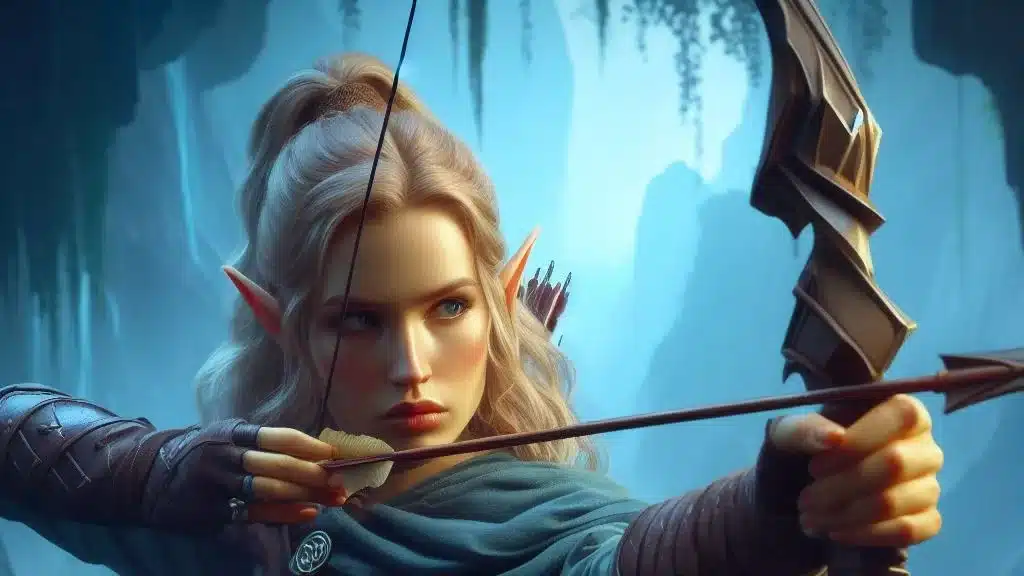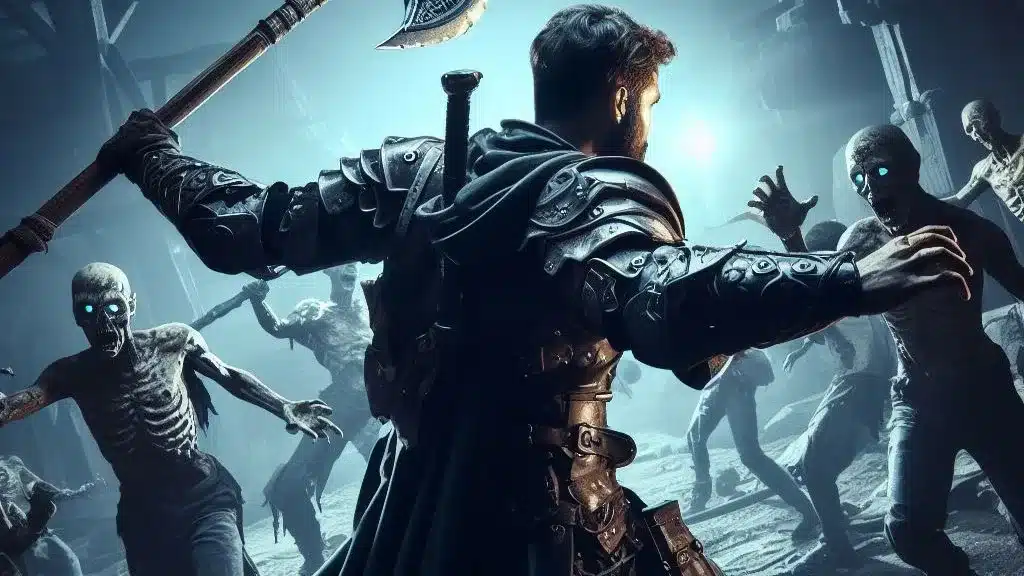| Fighting Style | Description | Class(es) | Source |
|---|---|---|---|
| Archery | +2 to attack rolls with ranged weapons | Fighter, Ranger | PHB |
| Blessed Warrior | +2 Cleric cantrips | Paladin | TCoE |
| Blind Fighting | 10 feet of Blindsight | Fighter, Paladin, Ranger | TCoE |
| Defense | +1 AC while wearing armor | Fighter, Paladin, Ranger | PHB |
| Druidic Warrior | +2 Druid cantrips | Ranger | TCoE |
| Dueling | +2 damage w/ a single one-handed melee weapon | Fighter, Paladin, Ranger, Swords Bard | PHB |
| Great Weapon Fighting | Reroll 1s and 2s on damage rolls made with two-handed melee weapons | Fighter, Paladin | PHB |
| Interception | Reduce attack damage against an ally within 5 ft by 1d10 + Proficiency Bonus (reaction) | Fighter, Paladin | TCoE |
| Protection | Impose disadvantage on attack against an ally within 5 ft while using a shield (reaction) | Fighter, Paladin | PHB |
| Superior Technique | Learn a Battle Master Maneuver and gain 1d6 Superiority Die | Fighter | TCoE |
| Thrown Weapon Fighting | +2 damage with thrown weapons, and can draw thrown weapons with Attack action | Fighter, Ranger | TCoE |
| Two-Weapon Fighting | Add ability score modifier to damage roll of off-hand weapon | Fighter, Ranger, Swords Bard | PHB |
| Unarmed Fighting | Unarmed attacks deal 1d6 + Strength (or 1d8 if not wielding weapon or shield) | Fighter | TCoE |
Fighting Styles 5e
Fighting styles offer a way for martial classes in DnD 5e to specialize into a certain playstyle. Whether it’s becoming more accurate with a bow, dealing more damage with two-handed weapons, or getting a greater benefit from armor, fighting styles are an essential part of some classes in 5e.
But they’re not all created equal — I’ll rank all the fighting styles in 5e from best to worst to help you decide which is right for your character. I’ll also cover a few common questions about the rules behind fighting styles.
Fighting Styles 5e Ranked Best to Worst
Here’s my opinion on which fighting styles are worth picking and which are worth skipping in DnD 5e. Note that your character build ultimately plays a big role in making this decision — a character who gets a lot of benefits from attacking a lot will get more value from two-weapon fighting than someone who wants to hit fewer, harder-hitting attacks, for example.
-
Archery (Fighter, Ranger)
You gain a +2 bonus to attack rolls you make with ranged weapons.Mathematically, the Archery fighting style is unequivocally the best fighting style in DnD 5e. It boosts your to-hit chance with ranged weapons by 10 percentage points (which works out to about a 15% damage increase, assuming your normal to-hit chance is 65% – which 5e’s system of bounded accuracy does assume).
If you’re planning on making most of your attacks with a ranged weapon, this is a no-brainer: pick the Archery fighting style 100% of the time, as early as you can. You’re basically starting the game off with a +2 weapon, which is absolutely bonkers, since that’s something usually reserved for level 10+ of play in most games.
-
Defense (Fighter, Paladin, Ranger)
While you are wearing armor, you gain a +1 bonus to AC.+1 AC might not be particularly sexy, but in DnD 5e’s system of bounded accuracy, it’s actually incredibly good. It puts you ahead of the game’s assumed math for to-hit chance, effectively reducing the frequency at which you’re hit by 7-8% (5 percentage points).
Plus, it’s just always on; no need to think about it or worry about changing your playstyle at a later time or for a specific fight. As long as you’re wearing armor and being targeted, the Defense fighting style is working for you.
-
Dueling (Fighter, Paladin, Ranger, Swords Bard)
When you are wielding a melee weapon in one hand and no other weapons, you gain a +2 bonus to damage rolls with that weapon.A no-nonsense +2 damage buff when you’re not dual-wielding or using a two-handed weapon, the Dueling fighting style is straightforward and effective. It allows you to use a shield with a one-handed weapon, bringing your damage in-line with a two-handed weapon user while still getting to benefit from the +2 AC of a shield.
That’s basically a flat +1.3 DPR (damage per round) (assuming a 65% chance to hit), or double that once you get Extra Attack. It’s a bit of bonus damage and allows for a lot more defense (even more than the Defense fighting style on its own), making it a well-rounded choice for any sword-and-board character.
-
Two-Weapon Fighting (Fighter, Ranger, Swords Bard)
When you engage in two-weapon fighting, you can add your ability modifier to the damage of the second attack.Two-weapon fighting (or dual-wielding in popular parlance) has a lot of issues in 5e. The fact that it requires your bonus action to attack with your “offhand” weapon makes it an unsuitable choice for characters that have a lot competing for their bonus action already (e.g., Rogues, some Barbarians, some Rangers, etc.)
BUT if you are building a dual wielder, two-weapon fighting is fantastic and helps mitigate that opportunity cost. At 1st-level, your attack ability modifier is probably +3, scaling to +5 by level 8 in normal circumstances. That’s basically +2 DPR while dual wielding, and it’s always “on,” so you’re always getting that benefit…unless you need to use your bonus action for something else that turn.
-
Blessed Warrior (Paladin)
You learn two cantrips of your choice from the cleric spell list. They count as paladin spells for you, and Charisma is your spellcasting ability for them. Whenever you gain a level in this class, you can replace one of these cantrips with another cantrip from the cleric spell list.Clerics get a lot of good cantrips that can help round out the Paladin kit. For instance, ranged attacks like Sacred Flame or Toll the Dead can give you a great option when you can’t get into melee range for some reason.
And utility spells like Thaumaturgy (minor magical tricks) and Guidance (+1d4 on an ability check) are very handy for out-of-combat scenarios.
-
Druidic Warrior (Ranger)
You learn two cantrips of your choice from the Druid spell list. They count as ranger spells for you, and Wisdom is your spellcasting ability for them. Whenever you gain a level in this class, you can replace one of these cantrips with another cantrip from the Druid spell list.Druids get some handy cantrips that really round out the Ranger playstyle. Magic Stone can be great early game if you don’t mind the low range and favor a sling, Create Bonfire offers decent battlefield control in tight spaces, Frostbite is a decent defensive spell (disadvantage on the target’s next weapon attack), and Thorn Whip is one of my favorite cantrips in the game (pull a target 10 feet closer while also dealing 1d6 piercing damage on hit).
Outside of added combat capabilities, Guidance (+1d4 on an ability check), Produce Flame (10-minute, no-concentration torch that you can sling as a 1d8 ranged spell attack), and Shape Water (too many uses to count here — check out my full guide) offer excellent added utility to the Rnager.
-
Blind Fighting (Fighter, Paladin, Ranger)
You have blindsight with a range of 10 feet. Within that range, you can effectively see anything that isn’t behind total cover, even if you’re blinded or in darkness. Moreover, you can see an invisible creature within that range, unless the creature successfully hides from you.Invisible creatures are kind of rare, but blindsight shines most effectively when you’re fighting in the Darkness or Fog Cloud spells. No attack disadvantage for you, but attackers have disadvantage attacking you. This is really solid if your party utilizes these tactics often, less so if they don’t.
-
Thrown Weapon Fighting (Fighter, Ranger)
You can draw a weapon that has the thrown property as part of the attack you make with the weapon. In addition, when you hit with a ranged attack using a thrown weapon, you gain a +2 bonus to the damage roll.Most DMs handwave the need to draw a weapon before throwing it anyway (since players can cheese it by just dropping their current weapon instead of sheathing it anyway), but the second part of Thrown Weapon Fighting is solid — a flat +2 damage bonus.
This fighting style is only really worth it if you’re planning on building a hoplite-type character that tosses javelins and the like around as a primary mode of attack; otherwise, you’re better off with a different fighting style.
-
Superior Technique (Fighter)
You learn one maneuver of your choice from among those available to the Battle Master archetype. If a maneuver you use requires your target to make a saving throw to resist the maneuver’s effects, the saving throw DC equals 8 + your proficiency bonus + your Strength or Dexterity modifier (your choice.)You gain one superiority die, which is a d6 (this die is added to any superiority dice you have from another source). This die is used to fuel your maneuvers. A superiority die is expended when you use it. You regain your expended superiority dice when you finish a short or long rest
Battle Master maneuvers are really strong (it’s why that subclass ranks as top-tier among Fighter subclasses). While it’s a little lame that you only get one superiority die per rest (and thus can only make 1-3 maneuvers a day typically) and that your superiority die never scales past 1d6, some maneuvers are strong and versatile enough for this fighting style to still be strong.
Riposte is great for weaponizing your reaction with a free attack when an enemy misses you, Menacing Attack is a great way to frighten an enemy into having disadvantage on attacks until your next turn, and Precision Attack is a no-nonsense +1d6 to hit, usable after your attack misses. There are others worth considering, but these are the most universally and easily applicable.
-
Unarmed Fighting (Fighter)
Your unarmed strikes can deal bludgeoning damage equal to 1d6 + your Strength modifier on a hit. If you aren’t wielding any weapons or a shield when you make the attack roll, the d6 becomes a d8.At the start of each of your turns, you can deal 1d4 bludgeoning damage to one creature grappled by you.
If you’re building a brawler character who loves to grapple often (hint: Fighter/Barbarian multiclass), Unarmed Fighting is a solid option. It increases your unarmed damage by +1d6 or +1d8, and gives you a free (albeit low-damage) attack against a creature you’re grappling.
Overall, though, most character builds won’t get much value out of this fighting style in my experience.
-
Great Weapon Fighting (Fighter, Paladin)
When you roll a 1 or 2 on a damage die for an attack you make with a melee weapon that you are wielding with two hands, you can reroll the die and must use the new roll, even if the new roll is a 1 or a 2. The weapon must have the two-handed or versatile property for you to gain this benefit.Great Weapon Fighting loses out to other offensive fighting styles because of math. The average increase on a 1d12 weapon by rerolling a 1 or 2 is only +1.2 — much lower than Dueling’s +2, two-weapon fighting’s +ability modifier damage, or Archery’s +2 on attack rolls.
That being said, if your character is using two-handed weapons, there’s not much reason NOT to take this mechanically inferior fighting style…unless you’re wearing armor — then, just the Defense fighting style for +1 AC and call it a day, IMHO.
-
Interception (Fighter, Paladin)
When a creature you can see hits a target, other than you, within 5 feet of you with an attack, you can use your reaction to reduce the damage the target takes by 1d10 + your proficiency bonus (to a minimum of 0 damage). You must be wielding a shield or a simple or martial weapon to use this reaction.Tasha’s Cauldron of Everything introduced the Interception fighting style as a somewhat superior defensive option to Protection (at the bottom of this list). But it still requires you to be within 5 feet of the ally you hope to help, which…well, they shouldn’t be near the tank in the first place if they’re squishy.
Plus, it eats your reaction, and you need to be wearing a shield for it to work. Honestly, the Defense fighting style (a flat +1 AC) is just mechanically superior to this and is useful 100% of the time, so it’s not really worth picking as a fighting style (although it does offer cool roleplaying moments of saving your buddy, every now and then).
-
Protection (Fighter, Paladin)
When a creature you can see attacks a target other than you that is within 5 feet of you, you can use your reaction to impose disadvantage on the attack roll. You must be wielding a shield.The worst fighting style in 5e, Protection is a real letdown. Like Interception, it requires you to be within 5 feet of your ally, uses your reaction, and requires you to be using a shield.
All that, for disadvantage on a single attack roll. It’s widely regarded as a “must-skip” fighting style, so really, choose anything else.


![Two-Weapon Fighting 5e [DnD Rule Guide] dnd-5e-dwarf-vs-orc](https://www.dndlounge.com/wp-content/uploads/2022/03/dnd-5e-dwarf-vs-orc-300x157.jpg)


![Starting Gold by Level 5e [DnD Guide + Equipment Suggestions] dnd-5e-dragon-hoard](https://www.dndlounge.com/wp-content/uploads/2022/03/dnd-5e-dragon-hoard-300x157.jpg)